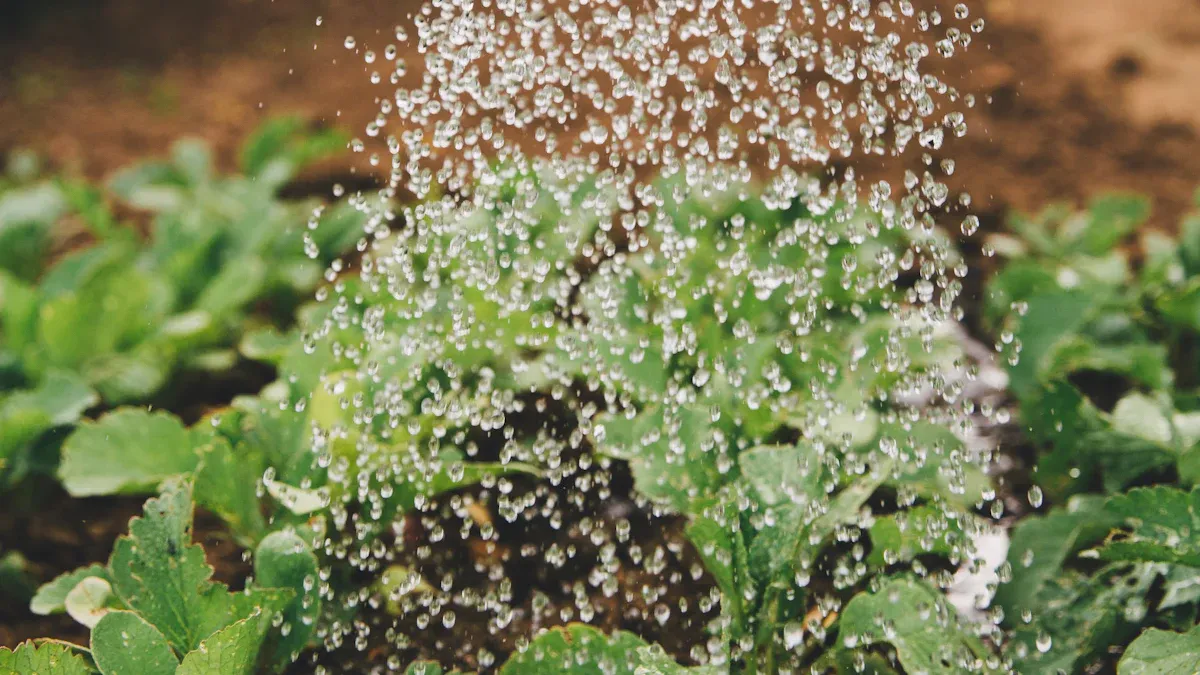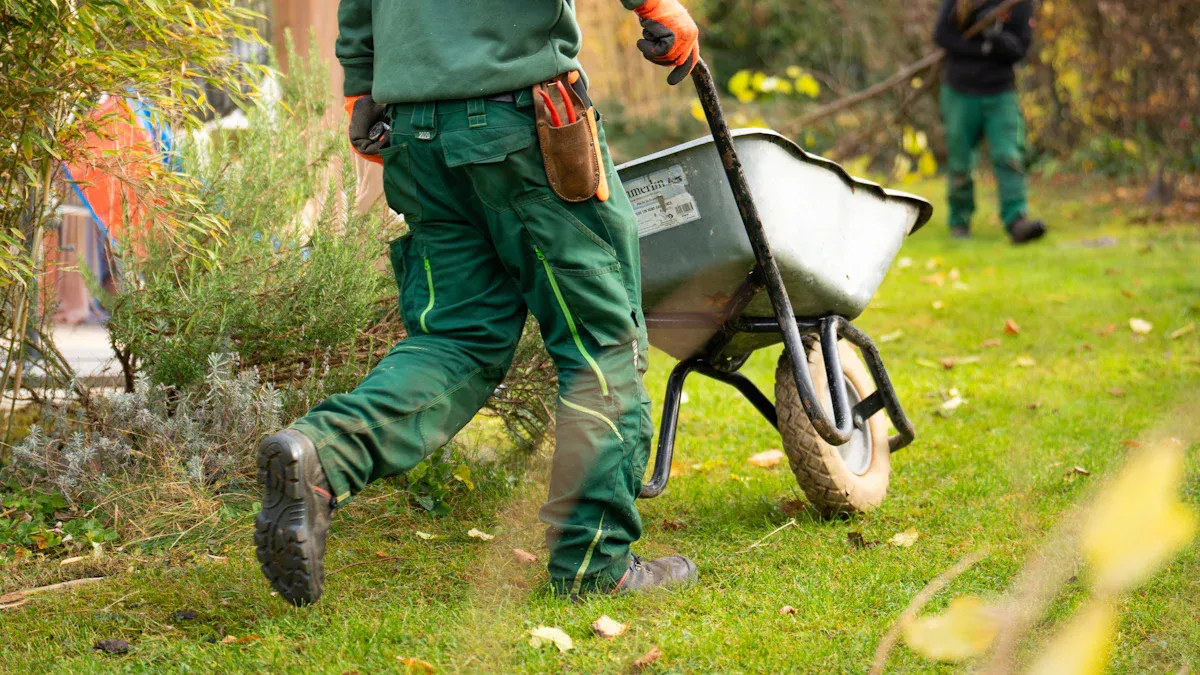
Diatomaceous earth (DE) is a natural substance made from fossilized algae. It offers numerous benefits for outdoor use, such as pest control and soil enhancement. By using DE, you can create a healthier environment for your plants and reduce the need for harmful chemicals. Choosing the right type of diatomaceous earth is crucial for your specific applications. Always consider safety, as not all grades are suitable for every use.
Here are some key benefits of using diatomaceous earth:
Acts as a natural pest deterrent.
Improves soil structure and drainage.
Provides essential nutrients for plants.
The global diatomite market is expanding, projected to grow from USD 1.18 billion in 2024 to USD 1.88 billion by 2032, highlighting its increasing popularity in outdoor applications.
Key Takeaways
Choose food-grade diatomaceous earth for safe pest control around pets and children.
Reapply diatomaceous earth after rain or watering to maintain its effectiveness against pests.
Use diatomaceous earth to improve soil health by enhancing moisture retention and nutrient availability.
Apply diatomaceous earth carefully to avoid harming beneficial insects in your garden.
Always read product labels to ensure you select the right grade and quality of diatomaceous earth.
Diatomaceous Earth Types

Food-Grade Diatomaceous Earth
Food-grade diatomaceous earth is safe for human and animal consumption. It primarily consists of amorphous silica, which means it has a low crystalline silica content. This type of diatomaceous earth must meet strict safety standards. For example, it must adhere to heavy metal content specifications, ensuring that harmful substances like arsenic and lead remain below acceptable limits.
Here’s a quick comparison of food-grade and non-food grade diatomaceous earth:
Type of Diatomaceous Earth | Composition | Safety Standards |
|---|---|---|
Food Grade | Mostly amorphous silica, less than 1% crystalline silica | Must meet heavy metal content specifications (e.g., arsenic and lead limits) |
Non-Food Grade (Pool Grade) | Calcined, contains high concentrations of crystalline silica | Not safe for human or animal consumption, used only for filtration |
You can use food-grade diatomaceous earth in various outdoor applications, such as pest control and soil amendment. It is effective against insects and can improve soil health by enhancing drainage and nutrient availability.
Non-Food Grade Diatomaceous Earth
Non-food grade diatomaceous earth, often referred to as pool grade, contains higher levels of crystalline silica. This type is not safe for consumption and is primarily used in industrial applications. You might find it in products like pool filters, abrasives, and insulation materials.
Common uses for non-food grade diatomaceous earth include:
Water filtration
Ingredient in dynamite
Pest control in non-food settings
Paint and coatings industry
While non-food grade diatomaceous earth serves many purposes, it is crucial to keep it away from pets and children due to its potential health risks.
The particle size of diatomaceous earth significantly affects its effectiveness. Smaller particles, particularly those under 10 microns, enhance the absorbent properties of the material. This leads to better dehydration of pests, making it more effective for pest control. Here’s how different particle sizes impact efficacy:
Particle Size (μm) | Efficacy Against Insects |
|---|---|
< 45 | Higher efficacy |
> 45 | Lower efficacy |
Applications for Outdoor Use

Pest Control
Diatomaceous earth (DE) serves as an effective solution for pest control in outdoor environments. You can use it to manage a variety of pests, including ants, bedbugs, and roaches. DE works by absorbing oils and fats from the exoskeletons of insects, leading to dehydration. The sharp edges of DE act abrasively, which speeds up this drying process.
Here are some key points about using diatomaceous earth for pest control:
DE is non-poisonous and does not require ingestion to be effective.
It remains effective when kept dry and undisturbed.
You can apply it as a dust on surfaces where pests are likely to travel.
To maximize its effectiveness, sprinkle diatomaceous earth at the base of plants or create a barrier that pests won’t cross. Remember, it is particularly useful against crawling insects like:
Ants
Fleas
Spiders
Termites
Soil Amendment
Using diatomaceous earth as a soil amendment can significantly improve your garden’s health. DE enhances moisture retention, allowing soil to stay moist longer. This is especially beneficial during dry spells. Additionally, it improves nutrient availability, making essential nutrients more accessible to your plants.
Here’s how diatomaceous earth benefits soil quality:
It retains moisture effectively, acting as a reservoir for water.
It enhances nutrient availability by trapping nutrients in its porous structure.
It improves soil structure by creating air pockets that facilitate aeration.
When applying diatomaceous earth to your soil, consider the following application rates based on soil type:
Soil Type | Application Rate |
|---|---|
Potting Soil | Mix DE at a ratio of 1:4 (1 part DE to 4 parts soil) |
Garden Soil | Apply 1-2 cups of DE per square foot, working it into the top 2-3 inches of soil |
Deodorizing
Diatomaceous earth also acts as a natural deodorizer. Its porous structure allows it to absorb odors effectively. You can place it in areas prone to unpleasant smells, such as compost bins or pet areas. This helps maintain a fresher environment without the use of harsh chemicals.
When using DE for deodorizing, keep these safety tips in mind:
Wear protective gear. Use a mask or respirator, protective eyewear, and gloves to prevent inhalation and skin exposure.
Apply carefully. Use the correct amount and consider using a puffer for targeted application.
Keep out of reach of kids and pets. Store diatomaceous earth in a secured container.
Weather conditions can affect the performance of diatomaceous earth. Rain can wash it away, so you should reapply it after watering or rainfall. For best results, apply DE on windless days with no rain forecasted for 24 to 48 hours.
Choosing the Right Grade of Diatomaceous Earth
Reading Labels
When you choose diatomaceous earth, reading the label is essential. The label provides crucial information about the product’s quality and safety. Look for the guaranteed analysis, which shows the nutrient content and moisture levels. This analysis helps you understand what you are buying. In Texas, some products must also list ash content, indicating the presence of inorganic minerals. This information can guide you in selecting a high-quality product.
Here are some tips for reading labels effectively:
Check for food-grade certification: This ensures safety, especially if you have children or pets.
Look for processing details: Knowing where the DE is mined and how it is processed can affect its safety and effectiveness.
Review application instructions: Proper application methods and timing are crucial for achieving the best results outdoors.
Understanding Product Purity
Understanding product purity is vital when selecting diatomaceous earth. You want to ensure that the DE you choose is free from harmful contaminants. Food-grade diatomaceous earth is safe for topical use and often used in pest management. However, it can cause slight lung irritation with long exposure. On the other hand, pool-grade diatomaceous earth is treated with high heat and can be harmful to your respiratory system.
To help you choose the right grade of diatomaceous earth, consider these factors:
Type of Diatomaceous Earth: Always opt for food-grade DE for safety in areas with children and pets.
Quality Factors: Investigate where the DE is sourced and how it is processed. This knowledge affects its safety and effectiveness.
Popular Brands: Brands like Safer® and Garden Safe® offer effective options for pest control and organic gardening.
By paying attention to labels and understanding product purity, you can make informed decisions when choosing the right grade of diatomaceous earth for your outdoor needs.
Safety and Environmental Considerations
Health Risks
When using diatomaceous earth, you must be aware of potential health risks, especially with non-food grade varieties. Inhaling diatomaceous earth can lead to serious lung issues. The silica in DE can cause significant inflammation and scarring in your lungs. If you have existing lung problems, using DE may worsen your condition.
Do not inhale DE. The silica in DE will cause significant inflammation and scarring in your lungs. If you suffer from lung problems, the use of DE may exacerbate your condition. Even accidental inhalation may lead to significant consequences.
To protect yourself while applying diatomaceous earth outdoors, consider using the following personal protective equipment:
Use a regular dust mask to avoid inhalation of diatomaceous earth.
A plain paper particle mask is sufficient for protection.
Safety glasses are also recommended to protect the eyes.
Here are some frequently reported side effects of diatomaceous earth exposure:
Side Effect | Description |
|---|---|
Serious lung problems | Exposure can lead to severe lung issues, including lung cancer. |
Skin irritation | Rubbing on the skin may cause wounds or loss of skin parts. |
Long-term respiratory issues | Potential for chronic respiratory problems with prolonged exposure. |
Environmental Impact
Diatomaceous earth can also affect the environment, particularly beneficial insects and pollinators. While DE acts as a non-chemical pesticide, it does not discriminate between harmful pests and helpful insects.
Diatomaceous earth can harm beneficial insects and pollinators if they come into direct contact with it. It is important to apply DE carefully to minimize unintended effects on these helpful garden inhabitants.
To maintain a healthy ecosystem, apply diatomaceous earth with caution. Ensure that you do not disrupt beneficial insects like ladybugs or bees.
Additionally, diatomaceous earth remains effective as long as it stays dry. Its effectiveness decreases quickly when it comes into contact with moisture. Therefore, you must reapply it after rain or heavy moisture exposure to ensure continued pest control.
Diatomaceous earth’s effectiveness is maintained in dry conditions.
Exposure to moisture significantly reduces its efficacy.
Reapplication is required after rain or heavy moisture to maintain pest control.
By understanding these safety and environmental considerations, you can use diatomaceous earth responsibly and effectively in your outdoor spaces.
In summary, understanding the types and applications of diatomaceous earth is essential for effective outdoor use. Here are some key takeaways to consider:
Key Takeaway | Description |
|---|---|
Safety for pets and humans | Diatomaceous earth is a natural repellent that does not harm pets or humans. |
Regular reapplication needed | To maintain effectiveness, diatomaceous earth must be reapplied after rain or wind. |
Creates a barrier against pests | It forms a barrier that leads to dehydration of scorpions, effectively controlling their presence. |
By making informed choices, you can maximize the benefits of diatomaceous earth in your outdoor spaces.
FAQ
What is diatomaceous earth used for?
Diatomaceous earth is used for pest control, soil amendment, and deodorizing. It helps manage pests naturally, improves soil health, and absorbs odors in various outdoor settings.
Is diatomaceous earth safe for pets?
Food-grade diatomaceous earth is safe for pets. However, avoid using non-food grade DE around them, as it can cause respiratory issues and other health risks.
How often should I apply diatomaceous earth?
You should reapply diatomaceous earth after rain or heavy watering. This ensures it remains effective in controlling pests and improving soil quality.
Can I use diatomaceous earth indoors?
Yes, you can use food-grade diatomaceous earth indoors for pest control. It is safe for use around children and pets when applied correctly.
How do I store diatomaceous earth?
Store diatomaceous earth in a cool, dry place. Keep it in a sealed container to prevent moisture absorption and maintain its effectiveness.

